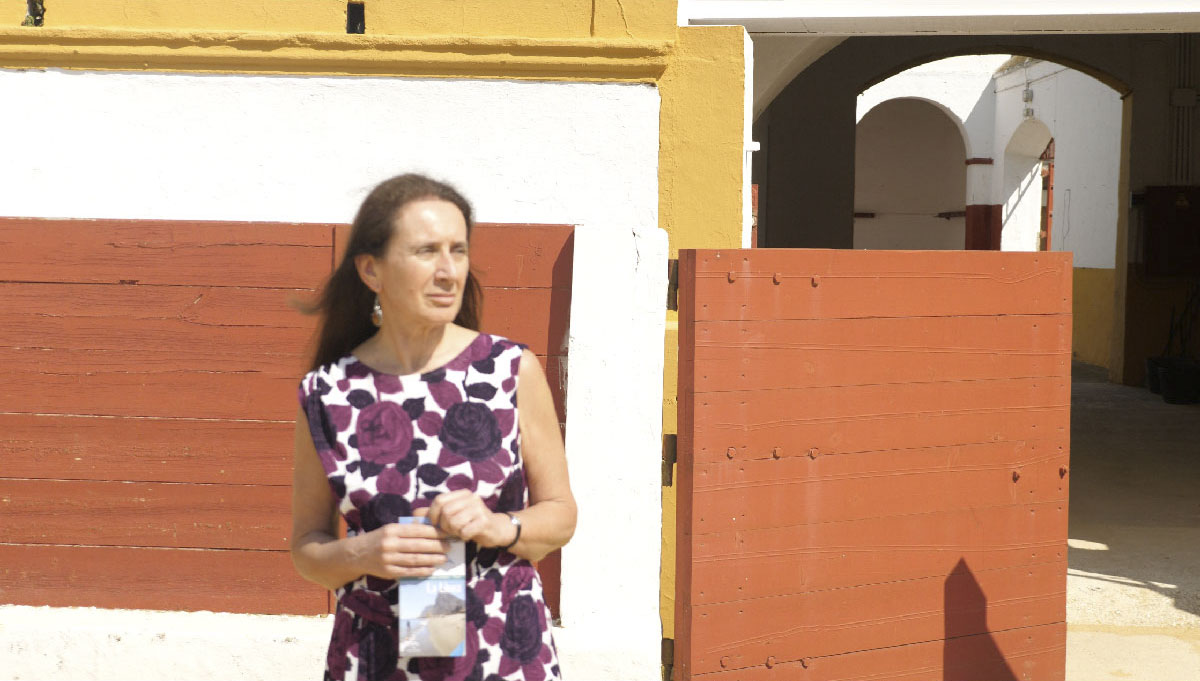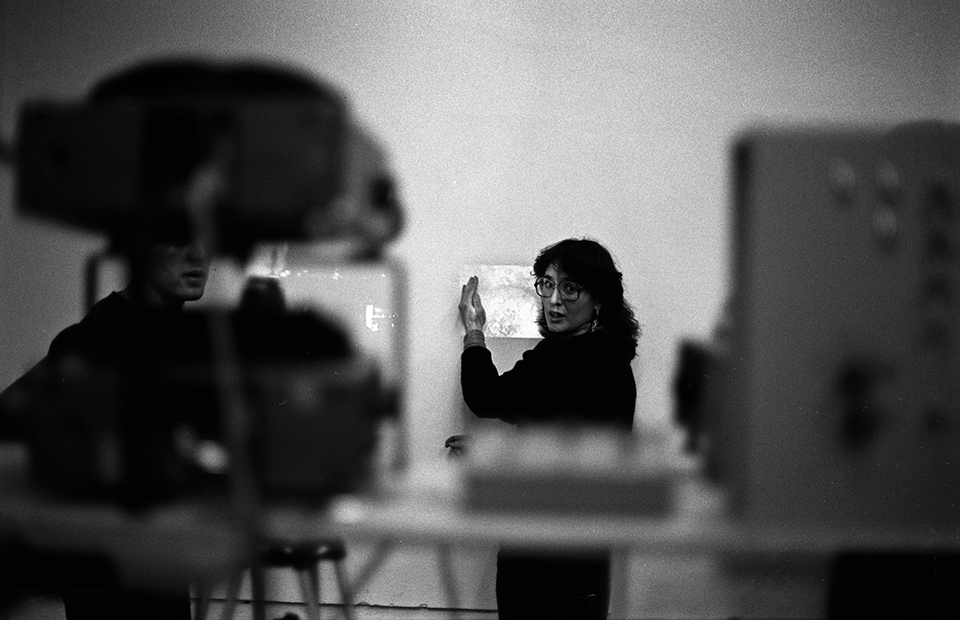Nina Danino was born in Gibraltar and came to London to study Fine Art in the 70s. Her films have been shown worldwide in film festivals including Edinburgh (1985), London (1992, 1998), Chicago (1994), Ann Arbor, US (2016), in cinemas; Pacific Film Archives, San Francisco (1994), NFT (2011, 2023), ICA, London (2016), Anthology Film Archives, New York (2017), Tate Modern (2016) and recently at the London Film Festival (2019), Seville European Film Festival (2019).
She has taught at Sheffield Hallam University, Architectural Association School of Architecture and since 2000 at Goldsmiths, University of London. She studied Painting at St. Martin’s School of Art (1973-1977) and at Environmental Media, Royal College of Art (1979-81) London where she made the multimedia work First Memory (1980-81) using slide/tape, S8 and 16mm film and her voice to narrate. She developed her practice in experimental film as a member of the London Filmmakers’ Co-operative 1981-1992. She was also a member of the editorial collective of the journal Undercut 1981-1990 which published on experimental and artists’ film and video and is Co-Editor of The Undercut Reader (2002).
Her interests have centred on experimental and languages of film, theory of structural/materialist film, notions of subjective inscription and the ‘feminine’ in film, the voice as an element in cinema and on the film soundtrack in relation to the image. She engaged with psychoanalysis through the writings of Kristeva and Lacan which inform her notions of the ‘feminine’. They have featured networks of nuns, saints, singers, The Virgin, literary figures Molly Bloom, St Teresa, Nico, Maria Callas.
Nina Danino’s seminal short film Stabat Mater (1990) used her speaking voice and fast editing, Joyce as a literary text and the saeta – a religious song which evokes intense and strong emotion. With Stabat Mater (1990) she added the impact of Catholic aesthetics, religious motifs and discourse to experimental film.
She then made “Now I am yours” (1992) which is arguably one of her most well-known films being exhibited internationally. This film combines the visionary writings of the mystic Teresa of Avila and her own poem-writing. Visually it is centred on Bernini’s The Ecstasy of Saint Teresa in Rome, mixed with footage on S8, VHS, 35mm and Hi 8 formats where these parts all come together in one whole in a performative drama of ecstasy. During the 90s she collaborated with avant-garde singers Shelley Hirsch, Sainkho Namtchylak in commissioning and scripting original compositions and included published songs by Diamanda Galas in “Now I am yours” (1992). She combined vocals and spoken word in the soundtracks to these films. These two films and The Silence is Baroque (1997) are published in the DVD Rupture/Rapture/Jouissance – The Religious Trilogy published by LUX (2028).
In 1997 she made the landscape film Temenos (1998) with a soundtrack by Sainkho Namtchylak with additional parts by Shelley Hirsch and mezzo soprano Catherine Bott. In this film, the visible and invisible is filmed in places imbued with attributed apparitional events of the Virgin Mary. On a phenomenological plane it engaged with the presence of the image in cinema. The soundtrack is composed of voices sobbing, wailing, lamenting, crying and in soaring pitches to create a sound landscape of joy and terror. Temenos has been published on DVD by the BFI Avant-garde series and the soundtrack is available on CD. Temenos’ haunting images filmed on 35mm and soundtrack create an Other worldly place.
Theological film theory informs a strand of her work on the presence of the cinema image which has a meditative or even a contemplative potential. This underpins her new film Solitude (2022) as well as Temenos and Communion (2010) which is a short silent film photographed by Billy Williams OBE (The Exorcist 1973) on 35mm using classical Hollywood studio lighting. Communion has been shown in two solo film installations. With Communion she initiated a socially, as well as spiritually framed series of film portraits of religious women in community and as individuals. The films use formal observation, duration and foreground the presence of the camera and composition. Jennifer (2015) is feature length collaborative portrait with Jennifer del Corazón de Jesus who is an enclosed Discalced Carmelite nun. It was self-filmed in the enclosed monastery in Ronda, Spain. The multi-media, multi-part work Sorelle Povere di Santa Chiara (2015-18) was made in collaboration with the enclosed community of sisters in the monastery of Santa Chiara in San Marino, Italy which includes a 16mm film, a 6-channel audio, a video of interviews and an essay in an accompanying publication. It has been shown in solo and duo installations. Jennifer and Sorelle Povere di Santa Chiara combine structural and feminist approaches with self representations of women within institutional and individual devotional space.
Her next film “I Die of Sadness Crying For You” (2019) encompasses the strand of her work on the voice her field of musical influences expand to mainstream forms of music and song. This film stems from a long period of research where she rebuilt her acoustic memory network of popular music including lyrical genres of Latin American song such as boleros and popular music from Spain which she set out to map up to the 70s. This research is also recorded in a 3 hour conversation with her mother who supplements the knowledge and memory. The film “I Die of Sadness Crying For You” is one result of this map of song memory. The film centres on songs of unrequited love, yearning and longing called copla. Amassing a wealth of materials for further works on this topic, the film is a synthesis of this research in a personal essay film and copla as a reclamation of this lyrical form from the perspective of women’s experiences of love, rejection and social marginalisation. “I Die of Sadness Cry For You “ (2019) was shown at the London International Film Festival and at Seville European Film Festival.
She is a singer and performer and her live debut was I’m Dying (Yoko Ono) in Religion & Art Live (2023). Killing What’s Inside of You (2021), Let it Roll (2021), Ghost of Love (2021), When the Music’s Over (2021) and others are dance videos that can be framed within the history of women’s performance to camera, the address to the female gaze and the concept of ‘feminine’ jouissance as an ecstatic experience of enjoyment for the private self. She has made the song-videos Nocturn (2020), Sweet Child (2021) and others, bringing rock song covers and other songs into her creative art practice. Since 2020 she has collaborated with new and established musicians James Creed, Gagarin, Donna Matthews and sung the songs of Nico for the soundtrack to her film Solitude (2022). She is developing a Hildegard of Bingen project based on the nightmare visions of the composer and mystic. She is a member of the rock bank Mother’s Ruin.
Singing enables communication of profound emotion and an embodied practice of exaltation in the process. Thus, she considers the voice and the performance of singing as having a liminal relationship to embodied jouissance which in psychoanalysis touches the Real beyond the Symbolic and also captures impulses bordering on religious experience. The singer in “I Die of Sadness Crying For You” is presented as a Tragedienne, a larger than life figure with privileged access to the expression of profound emotion such as sorrow as well as performing a live creative act of surplus production. Her current projects explore the act of singing in these terms as itself as a ‘feminine’ production and in relation to film as a practice of self-inscription into her own films. Another way into this phase of her practice is through Nietzsche’s avant-garde artist as a model of self-rejuvenation, self-transmutation, self-transfiguration of self and audience and in which the artist is in a kind of habitual intoxication.
In relation to this, she is producing a diptych of two feature-length films based on two different forms – opera and avant-garde Gothic rock through two iconic singers Maria Callas (1923-1977) and Nico (Christa Paffgen) (1938-1988). This project explores the contralto and operatic voice through their associations with darkness and with transcendence and the demonic. The relationship of film materiality and the presence of the image to Transcendence.
Part one is her new feature-length film Solitude (2022) which is completed and is comprised of an assembly from four underground-experimental films which feature the singer Nico and newly filmed and newly composed sound including the recital of Romantic poetry. Thus her films have featured networks of symbolic and emblematic and real figures, nuns, saints, singers, The Virgin, literary figures Molly Bloom, St Teresa, Nico, Maria Callas. The recent film also deal with the inherent power of icons and at the same time challenge the artist’s power to adore, worship, inscribe and transform them anew.
She is currently producing part two of this project MARIA which is a feature-length experimental film on Maria Callas.
Since Close to Home (1982-85), a strand of Nina Danino’s work returns to the geographic and cultural memory of the Mediterranean and the south of Spain and Gibraltar where she was born. It features the epic geogeography of the Straits, views, and the geo-cosmology of a region which is filtered through literature, scripts, photographs, cinema films, music; Stabat Mater responded to this impulse. She has made several pieces including the large scale mixed media installation Meteorologies (2013, 2018) which includes these sources; artists’ book, audio, videos, film and writing as intersubjective maps of this region in Spain which to her resonates in a similar way as Italian Director Pier Paolo Pasolini’s relationship to destitution. She is developing a film project in this strand of her work under the title The Far South with dialogue and actors.
Her films are in the collection of the British Film Institute National Film Archive. Visionary Landscapes is an illustrated monograph published by Black Dog Publishing (2005).
She is Reader in Fine Art, Goldsmiths, University of London. She lives and works in London.

